Jim's home | Trimaran home | This boat's home
Innovations
Better controls
Steering systems
Pivoting amas
Seats
All kinds of good things happened to this boat in the process of swapping the main hull (vaka). See below for details.
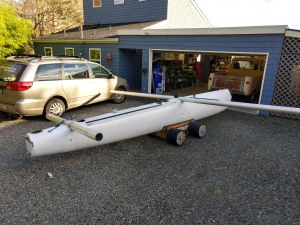
The Supercat 20 hull perched on it's dolley in the driveway. Trying out a new crossbar (aka) here. I abandoned the old, twisted french mast used as an aka on the first version. I bought a 20' 6061 aluminum 4.5" o.d. tube with 1/8" wall thickness from Interwest Metals in Tacoma for this. Cost about $200. It's the same diameter as the aka used for this hull when it was a catamaran. Supercat 20s use telescoping tubes for akas, so the boat can be made narrower or wider. They use a 4" tube to go into a 4.5" tube. Thankfully I got the aka with the bigger diameter saddle.
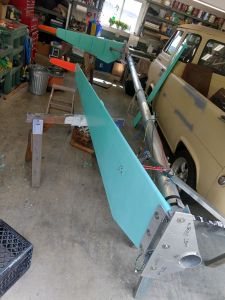
Well here' the whole new aka/foil assembly just prior to fitting it into the Supercat 20 hull's molded saddle.
Better controls - Return to top

The rudder deployment controls are much better here. The red rope pulls the small rudder up out of the water and can be cleated in the up position. The green rope pulls the small rudder down in the water and can be cleated in the down position.
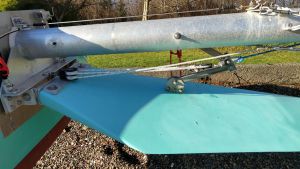
Main foil deployment and retracting system here. When the folding metal strut extends so it's straight, it goes a little past straight so it can safely "lock" into position. The blue rope on the right is pulled briefly to get the strut folding when retracting the foil into its "up" position. The white rope with the double block is pulled to straighten out the folding metal strut, thus pulling the foil into its "down" position.
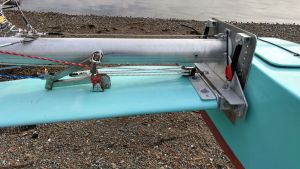
The red rope is used to retract the foil. It simply pulls the foil up towards the aka. Additional blocks were used in this version to make it easier to deploy and retract the foils.
Steering systems - Return to top

You can see the steering system on the 90s prototype of L'Hydroptere here. It's cable driven and uses a wheel plus a tiller. I couldn't really determine how it worked from the pictures I had, and I think there really must have been fine and course steering controls. Anyway, this made me think to use a steering wheel.
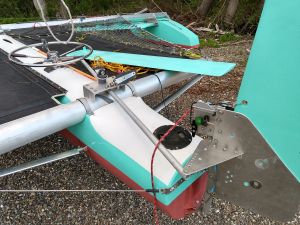
Well, this turned out to be a pretty wacky way to steer, especially when using it from different sides of the boat. You'd turn left when you meant right when foiling at high speeds, then overcorrect, then everything gets crazy.
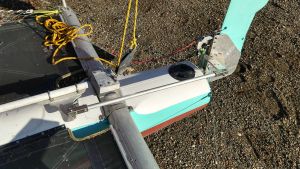
This way was much more successful and intuitive. Note the stainless steel fittings at the end of the control rod. I found that holes drilled in aluminum tubing would wear and elongate, causing slop. You really want precise steering control at high speeds.
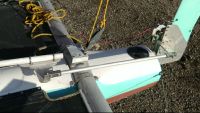
Video of final version of rudder control.
Pivoting amas - Return to top
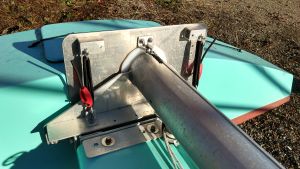
My canoe trimaran sailboat used a ladder for its aka. The outer hulls (amas) were attached to the ends of the ladder. The ladder twisted a lot, so the amas could easily pitch nose up or down. It seemed to be a good thing since it rode smoothly over swells this way. So I devised these pivoting amas. They swiveled independently from the foils' angle of attack. Shock cord was used to modulate the pivoting.
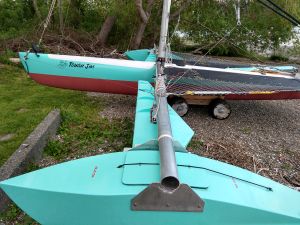
Outside view of new ama attachment.
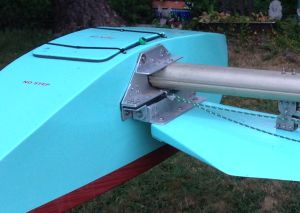
Old ama attachment.
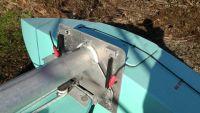
Video showing pivoting amas.
Seats - Return to top
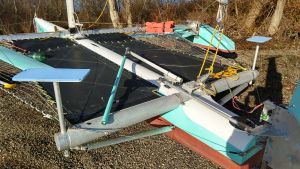
I eventually learned to control Tough Jim while foiling so I was wishing I could sit down. Also when simply sailing in non-foiling mode. So my friend John welded some aluminum plates onto some pipe for me. Used a hole saw to drill through the ends of the big aluminum tube. Pins secure the pipe to the tube. Height-adjustable too. Then a sleeping pad spray glued onto the plate. Very comfy actually and light. A tad unsafe though as you scoot backwards feeling around for the seat while flying along. Don't want to miss the seat when sitting down.
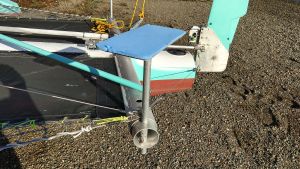
Pins visible at the tube/pipe junction.
Continue














